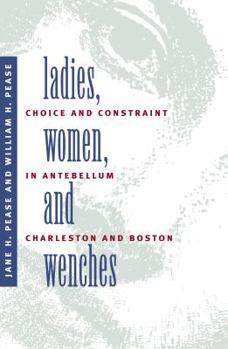Ladies, Women, and Wenches: Choice and Constraint in Antebellum Charleston and Boston
Select Format
Select Condition 
Book Overview
Pursuing the meaning of gender in nineteenth-century urban American society, Ladies, Women, and Wenches compares the lives of women living in two distinctive antebellum cultures, Charleston and Boston, between 1820 and 1850. In contrast to most contemporary histories of women, this study examines the lives of all types of women in both cities: slave and free, rich and poor, married and single, those who worked mostly at home and those who led more public lives. Jane Pease and William Pease argue that legal, political, economic, and cultural contraints did limit the options available to women. Nevertheless, women had opportunities to make meaningful choices about their lives and sometimes to achieve considerable autonomy.
By comparing the women of Charleston and Boston, the authors explore how both urbanization and regional differences -- especially with regard to slavery -- governed all women's lives. They assess the impact of marriage and work on women's religious, philanthropic, and reform activity and examine the female uses of education and property in order to illuminate the considerable variation in women's lives. Finally, they consider women's choices of life-style, ranging from compliance with to defiance of increasingly rigid social precepts defining appropriate female behavior.
However bound women were by society's prescriptions describing their role or by the class structure of their society, they chose their ways of life from among such options as spinsterhood or marriage, domesticity or paid work, charitable activity or the social whirl, the solace of religion or the escape of drink. Drawing on a variety of sources including diaries, court documents, and contemporary literature, Ladies, Women, and Wenches explores how the women of Charleston and Boston made the choices in their lives between total dependence and full autonomy.
By comparing the women of Charleston and Boston, the authors explore how both urbanization and regional differences -- especially with regard to slavery -- governed all women's lives. They assess the impact of marriage and work on women's religious, philanthropic, and reform activity and examine the female uses of education and property in order to illuminate the considerable variation in women's lives. Finally, they consider women's choices of life-style, ranging from compliance with to defiance of increasingly rigid social precepts defining appropriate female behavior.
However bound women were by society's prescriptions describing their role or by the class structure of their society, they chose their ways of life from among such options as spinsterhood or marriage, domesticity or paid work, charitable activity or the social whirl, the solace of religion or the escape of drink. Drawing on a variety of sources including diaries, court documents, and contemporary literature, Ladies, Women, and Wenches explores how the women of Charleston and Boston made the choices in their lives between total dependence and full autonomy.
Format:Paperback
Language:English
ISBN:0807842893
ISBN13:9780807842898
Release Date:October 1990
Publisher:University of North Carolina Press
Length:234 Pages
Weight:0.70 lbs.
Dimensions:0.5" x 5.5" x 8.5"
Customer Reviews
1 rating
Thorough and thought-provoking
Published by Thriftbooks.com User , 22 years ago
I purchased this book at the William Longfellow home and museum in Cambridge, MA several years ago. It is more of a dissertation in tone than a novel, but the anecdotes and illustrative examples make it an interesting read, assuming that you're interested in the subject matter to begin with. The first few pages are a bit dry, but once I got going I really wanted to finish it. The juxtaposition of women in Charleston and Boston in Jacksonian America is quite enlightening. Though the South has a reputation for male dominance, the women in Puritanical Boston were often much more constrained in their ability to influence social and political movements than their southern counterparts. Moreover, southern women could hold land and, if wealthy enough, could *choose* whether or not to marry (sometimes opting for the role of "spinster aunt") more freely than their New England sisters. A very interesting read that makes you examine how remarkably similar many of our modern-day social conventions and the roles of women are to those of the Antebellum US.






